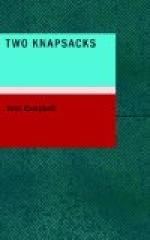“I would like to see that plant,” said Wilkinson. So they retraced their steps to the bank, over which Coristine leaned tenderly, picking something which he put into his mouth. “Come on, Wilks,” he cried; “it isn’t blite, but something better. It’s wild strawberries themselves, and lashings of them. Sure any fool might have known them by the leaves, even if he was a herald, the worst fool of all, and only knew them from a duke’s coronet.”
For a time there was silence, for the berries were numerous, and, although small, sweet and of delicate flavour.
“Corry, they are luscious; this is Arcadia and Elysium.”
“Foine, Wilks, foine,” mumbled the lawyer, with his mouth full of berries.
“This folly of mine, sitting down on the blessings of Providence—turning my back upon them, so to speak,” he remarked, after the first hunger was over, “reminds me of a man who took the gold medal in natural science. He had got his botany off by rote, so, when he was travelling between Toronto and Hamilton, a friend that was sitting beside him said, ‘Johnson, what’s in that field out there?’ Johnson looked a bit put out, but said boldly, ‘It’s turnips.’ There was an old farmer in the seat behind him, and he spoke up and said, ‘Turmuts!’ said he, ‘them’s hoats—ha, ha, ha!’”
As they tramped along, the botanist found some specimens: two lilies, the orange and the Turk’s cap; the willow herb, the showy ladies’ slipper, and three kinds of milkweed. He opened his knapsack, took out the strap press, and carefully bestowed his floral treasures between sheets of unglazed printers’ paper. Wilkinson took a friendly interest in these proceedings, and insisted on being furnished with the botanical names of all the specimens.
“That willow-herb, now, Epilobium angustifolium, is called fire-weed,” said the botanist, “and is an awful nuisance on burnt ground. There was a Scotchman out here once, about this time of the year, and he thought it was such a pretty pink flower that he would take some home with him. So, when the downy-winged seeds came, he gathered a lot, and, when he got back to Scotland, planted them. Lord! the whole country about Perth got full of the stuff, till the farmers cursed him for introducing the American Saugh.”
“The American what?” demanded Wilkinson.
“Saugh; it’s an old Scotch word for willow, and comes from the French saule, I suppose.”
“I am not sorry for them,” said Wilkinson; “they say that pest, the Canada thistle, came from the Old Country.”




